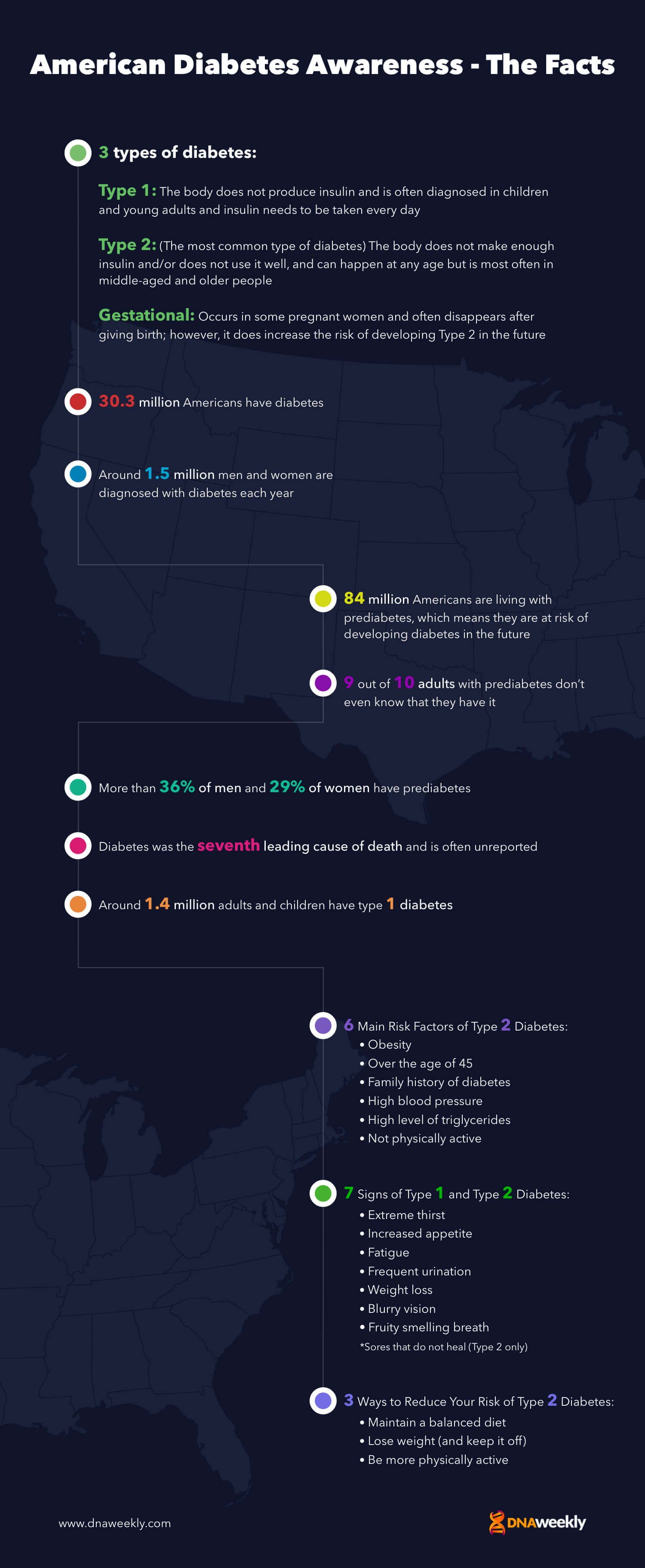
Every fourth Tuesday in March is American Diabetes Association Alert Day. This year, 2020, the awareness day falls on March 24. This means it’s once again time to talk about diabetes, which is one of the leading causes of death in the United States. So, let’s talk…
What Is Diabetes and Why Does It Matter?
Put simply, diabetes is a disease that means your blood glucose (or blood sugar) is too high. Diabetes occurs when the hormone insulin doesn’t do its job of transporting glucose out of your blood and into your cells, which could be because:
- You have type 1 diabetes (often from childhood), so your body – specifically your pancreas – doesn’t produce insulin.
- You have developed type 2 diabetes (often later in life) because your body is no longer responding to insulin in the way that it should.
American Diabetes Association Alert Day 2020
The American Diabetes Association Alert Day (Diabetes Alert Day, or simply Diabetes Day) is observed annually on the fourth Tuesday of March. In 2020, this means March 24.
Although we should think about such important issues all year round, this annual event acts as a timely reminder to give this disease the attention it deserves, especially since more than 30 million Americans are affected by diabetes.
It’s time to learn more and maybe even take a test to see if you have (or could develop) the disease yourself. Or, you can play a role in raising awareness by taking part in one of the many scheduled activities and events.
Important Diabetes Statistics

What Are the Risk Factors for Type 2 Diabetes?
Let’s talk about your risk of developing diabetes, which can depend on your family’s health history, as well as your genetics, race, age, activity levels, and other factors. You can change only some of these things, of course, but you shouldn’t ignore the ones you can’t.
Understanding your diabetes risk level will help you take steps to reduce it, such as (in the case of type 2 diabetes) making lifestyle and dietary changes. The more research you do, the better informed you’ll be, so let’s start by listing the main risk factors for developing type 2 diabetes:
- Being overweight
- Being over 45 years old
- Having a family history of diabetes
- Having high blood pressure
- Having a high level of triglycerides
- Being sedentary and not physically active
- Suffering from depression
- Having polycystic ovary syndrome (PCOS)
- Being an African American, Alaskan Native, American Indian, Asian American, Hispanic/Latino, Native Hawaiian, or Pacific Islander
None of these factors mean you’ll definitely develop type 2 diabetes, but taken together, they are indicative of increased risk.
How Can You Check for Diabetes?
With a large percentage of undiagnosed diabetes cases in the United States, it’s important to know how to get checked for the disease. A few things you can do are: look out for symptoms, take an online assessment, or submit an at-home DNA or blood test to assess your genetic predisposition or current levels. Let’s look at each one in turn.
Look Out for Symptoms
Prediabetes has no symptoms, so it’s hard to spot. That said, noticing the following signs could mean you already have diabetes (but it might not be as bad as it sounds).
If you have type 1 diabetes, you probably already know because you were diagnosed as a child. Nevertheless, the symptoms of type 1 diabetes that you should look out for – according to the American Heart Association – are:
- Extreme thirst
- Increased appetite
- Fatigue
- Frequent urination
- Weight loss
- Blurry vision
- Fruity smelling breath
The signs of type 2 diabetes are essentially the same, with the addition of:
- Sores that fail to heal
These symptoms don’t necessarily mean that you’re diabetic, but it’s definitely time to speak to your doctor about the possibility.
Take a Diabetes Risk Test
Since certain metrics (e.g., weight, blood pressure, ethnicity, etc.) are good indicators of diabetes risk, the American Diabetes Association has published an online Diabetes Risk Test that takes only a minute or so to complete.
Take an At-Home DNA or Blood Test
One way to test your blood glucose level, to see if it falls within the diabetic range, is to buy a cheap finger-prick glucose monitor from Amazon or eBay. This could be a good way of determining whether you should be talking to your doctor about diabetes. However, a better way might be to send a blood sample to a lab via an online service that tests your longer-term blood sugar levels reflected by the Hemoglobin A1c (HbA1c) in your blood.
Taking a step back, another kind of at-home test is based on the DNA that can be extracted from a cheek swab or saliva sample – no blood required. While this type of test can’t tell you if you currently have diabetic levels of blood sugar, it can tell you if you’re genetically predisposed to developing diabetes.
These are some of the best test providers on the market.
Vitagene: This vendor helps you achieve your full diet and fitness potential, based on your unique genetic makeup. While the DNA test won’t tell you if you’re predisposed to developing diabetes, it can offer some great insights (and a vitamin subscription) to help you improve your lifestyle, lowering your risk of developing a health condition.
Living DNA: The Wellbeing test can give you insight on how your body is likely to break down and metabolize sugars (as well as a number of other food types). Additionally, you’ll get diet and exercise recommendations designed to help you lose weight and keep it off. This can be a great resource if you are prediabetic and want to reduce your risk.
EasyDNA: This vendor’s All-In-One Health Testing Package report analyzes genetic predispositions to both type 1 and type 2 diabetes. The detailed report also includes an analysis of type 1 diabetes nephropathy, which will tell you whether you have an increased risk of cardiovascular disease and related conditions. (Please note that this test is not available in the US.)
Futura Genetics: The Futura Genetics Health test checks for predispositions to 28 of the most common diseases and conditions, including type 1 diabetes and type 2 diabetes. Your report will compare your risk vs. the average risk, and make suggestions for lifestyle changes you can make.
HealthCodes DNA: This vendor’s Wellness Panel includes a variety of reports that include information on your glucose cardio response and sugar preference, which could be related to your chances of developing type 2 diabetes. You’ll also learn more about your insulin sensitivity response.
Everlywell: The General Wellness tests also include an HbA1c test that measures your current blood sugar levels over the last 90 days, so you know whether to talk to your doctor about diabetes. Again, this is not merely a test of your genetic predisposition to diabetes. You can order a single test or save money with a monthly, quarterly, or semi-annual subscription.
LetsGetChecked: The individual Diabetes Test requires you to send in a blood sample (from a relatively painless finger prick), so it can test your HbA1c levels that reflect your long-term blood sugar levels. This is one of the tests your doctor would perform to determine if you are actually diabetic rather than merely predisposed to the disease.
TellmeGen: This is another option that can tell you your genetic predisposition to both type 1 diabetes and type 2 diabetes. Dozens of genes are analyzed to accurately compare your personal risk to the average risk for individuals of the same race, age, gender, and geographic location.
How to Reduce Your Risk of Type 2 Diabetes
If a blood test tells you that you have diabetic-level blood glucose, you should (of course) talk to your doctor without delay. If a DNA test tells you that you have a genetic predisposition to developing diabetes, you can start taking healthy steps to protect yourself, including:
Become More Physically Active
Leading a sedentary lifestyle can greatly increase your risk of developing type 2 diabetes. You should engage in at least 30 minutes of activity five days a week, but this doesn’t mean hitting the gym if you’d prefer to be dancing or running outside instead.
Lose Weight and Keep It Off
Carrying extra weight can put you at risk of developing type 2 diabetes, so use an online body mass index (BMI) calculator to make sure you’re at a healthy weight. Lose weight and keep it off if your BMI is too high.
Always Eat a Balanced Diet
Your diet can directly impact your chances of developing type 2 diabetes. Choosing a diet rich in healthy grains and low in trans-fats will help you lower your risk level. If in doubt, talk to a nutritionist or check out some of the best diet and fitness DNA tests for personal recommendations based on your unique genetic makeup.
The Takeaway! (Low Carb, Of Course!)
Although Diabetes Alert Day is only one day every year, it doesn’t mean we should ignore this disease during the other 364 days. Stay vigilant for the telltale signs, submit a test to put your mind at rest, take steps to reduce your risk, and (if you’re concerned) talk to your doctor. Also, don’t forget to do your bit to help raise awareness this Diabetes Day, March 24, 2020.
More Resources
- National Institute of Diabetes: https://www.niddk.nih.gov/health-information
- American Diabetes Association: https://www.diabetes.org
- American Heart Association: https://www.heart.org
- Diabetes Research Institute Foundation: https://www.diabetesresearch.org

